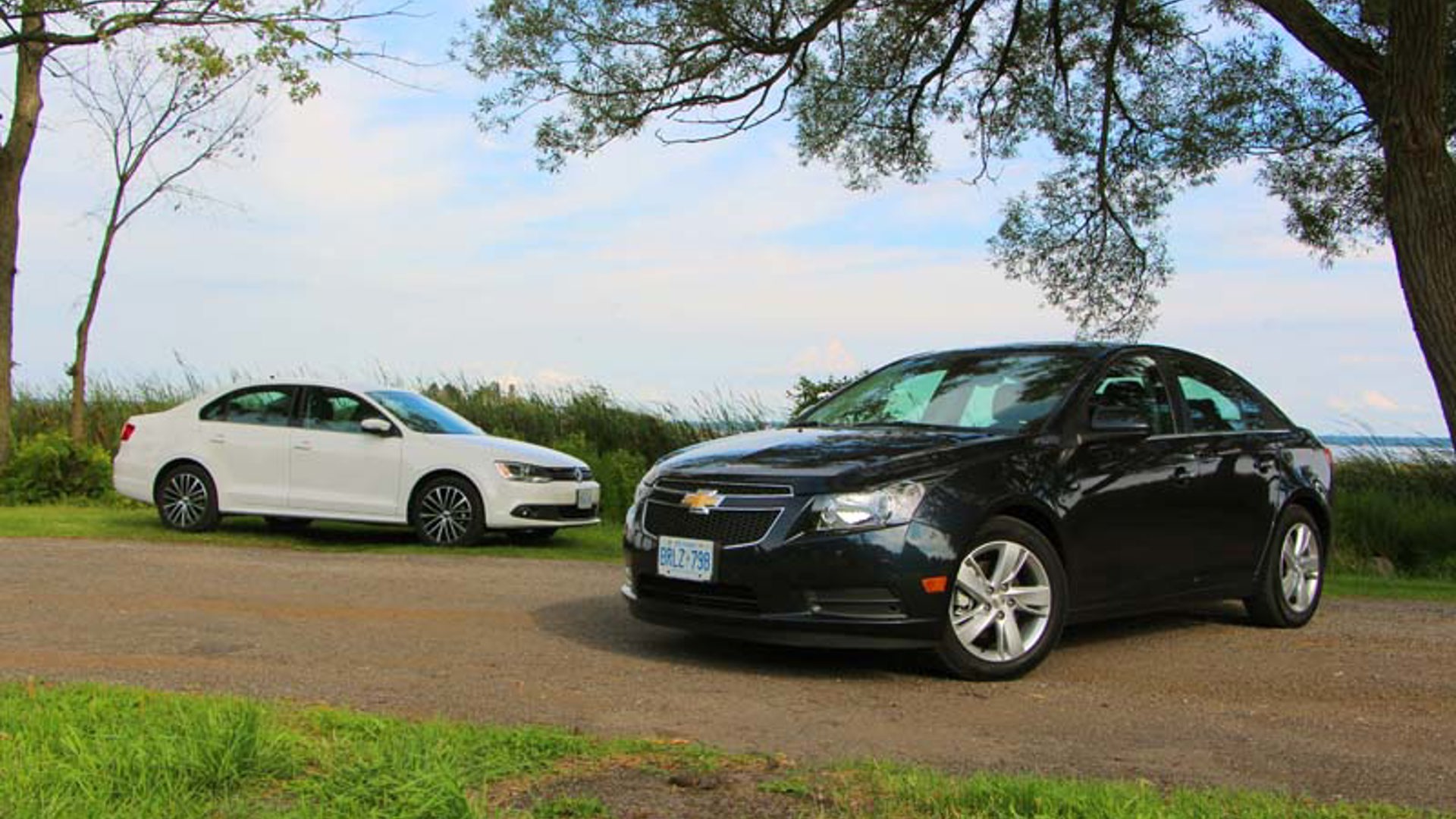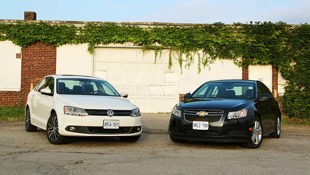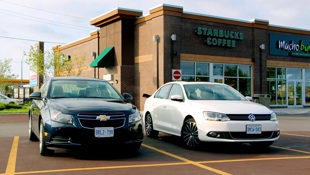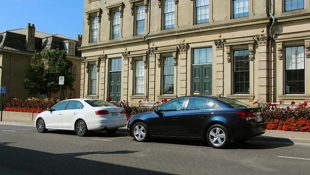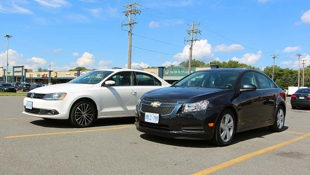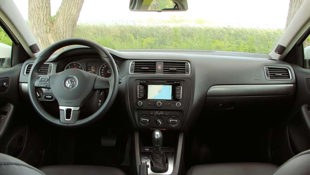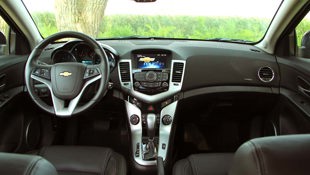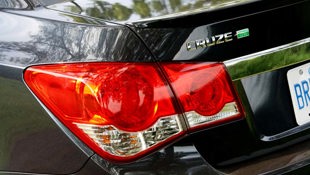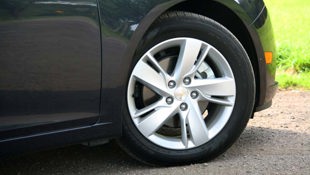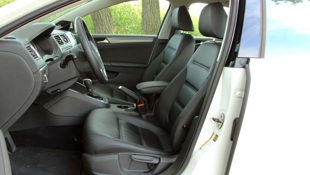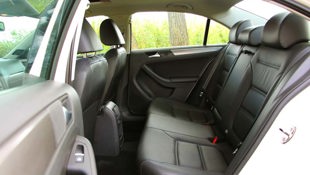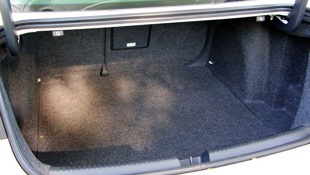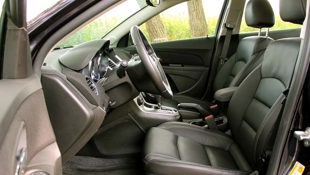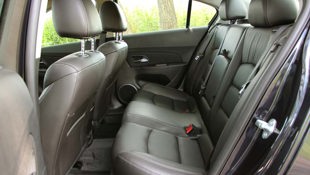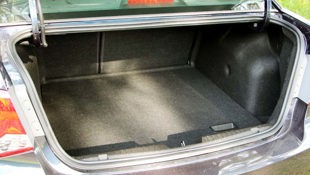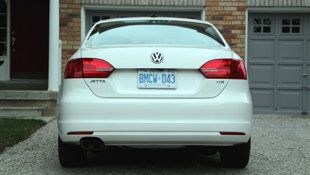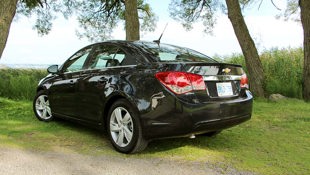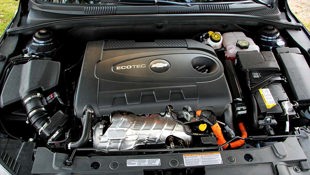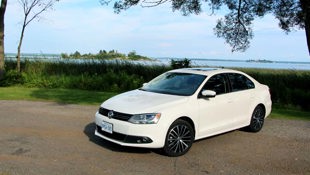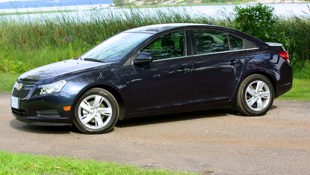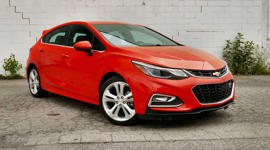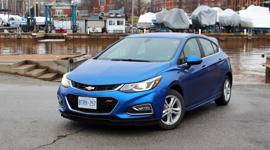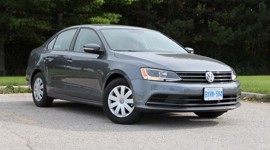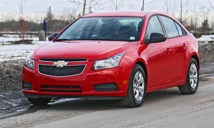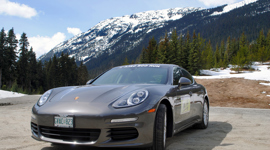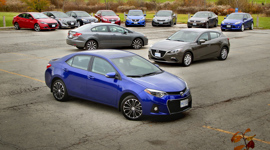Comparison Data
|
Base Price
$24,945
|
$27,290
|
|---|---|
|
A/C Tax
$100
|
$100
|
|
Destination Fee
$1,600
|
$1,395
|
|
Price as Tested
$29,810
|
$31,730
|
|
Optional Equipment
Enhanced Safety Package – $885, Sun and Sound Package – $1,485, Navigation – $795
|
DSG Automatic Transmission - $1,400, Technology package (Eight-speaker, 400-watt Fender audio system, rear-view camera and touchscreen-based navigation) - $1,545
|
It started something like this: “It's 540 kilometres to Montreal, we got two full tanks of diesel, half a pack of gum, it's too early in the morning and we're wearing sunglasses. Wait, damn, I think I lost my sunglasses.”
The mission, though not exactly from God, was simple: find out if one could drive between Canada’s two largest cities – Toronto to Montreal and back – on a single tank of gas. In a single day. And not exactly driving like the John and Helen Taylor (the hypermiling Australian couple that set the record for longest distance on a single tank of fuel in a 2012 Volkswagen Passat TDI), though not as recklessly as Jake and Elwood, either.
Crazy? Perhaps. But Senior Editor Jonathan Yarkony and I were going for it regardless, confident that the vehicles we chose were up to the task, not to mention us as drivers; we’ve both driven to from Toronto to Montreal countless times, but neither of us had done the 1,000-plus kilometre round trip in a single day.
Our cars were not hybridized, electrified magic-carpets full of techno-wizardry; just a couple of compact sedans powered by good ol’ internal combustion, but with what would probably be considered a twist in most North American markets.
Our steeds – a Volkswagen Jetta and Chevrolet Cruze – may seem innocuous, save for the fact that they were both powered by diesel powerplants. Indeed, the VW Jetta TDI and Chevrolet Cruze Clean Turbo Diesel may be part of a rare breed here in Canada, but if our experiences are any indication, that could – and should – change going forward.
The engine blueprints are almost identical: 2.0L inline-four-cylinders, a turbocharger each and direct fuel injection.
On paper, the Cruze pips the Jetta on the power front – 264 lb-ft of torque (280 with overboost) plays 236 in the Jetta and 11 more horsepower (151 to 140). But those numbers, while not huge upon first glance, actually make more of a difference than you might think.
Of course, in cars like these with a trip like this, fuel economy is paramount, so we felt confident that both the Jetta and Cruze’s claimed highway figures – 4.7 L/100 km for the Jetta, 4.2 for the Chevy – would make or break us as we made our way eastwards along Highway 401.
With tanks topped up, trip computers reset and coffee cups filled, we started out from a Shell station on the outskirts of Toronto. From there, we’d stop in Coburg, Ont. to refuel ourselves (that Yarkony guy requires a lot of refuelling) if not our cars, then continue straight on to our turnaround point in Montreal’s Dollard-des-Ormeaux neighbourhood (not exactly downtown Montreal, we know). The way back would consist of a more direct route, with a brief photo stop and driver change along the Thousand Islands Parkway that parallels the 401, starting just east of Gananoque, ON.
Features & Value
The Jetta TDI Clean Diesel is available in two trim packages – Comfortline and Highline; for the diesel lump in either of the two trims, be prepared to shell out an additional $2,300 for the privilege.
In the Cruze’s case, the Clean Turbo Diesel model comes in only one trim package with a base MSRP of $24,945.
The Jetta TDI, meanwhile, starts at $23,990 with a six-speed manual transmission; you can only have an auto with the Cruze, so for the sake of argument, we’ll add that option to our base Jetta, bringing its MSRP to $25,390.
So, if you opt for the Chevy, you’re actually paying less for more hp and torque. So far, so good for the Cruze.
Our Jetta Highline TDI’s $27,290 base MSRP provides leather seats (heated up front), 17-inch alloy wheels, Bluetooth and keyless entry. The only option available – which our car had – is the $1,545 Technology package, providing an eight-speaker, 400-watt Fender audio system, rear-view camera and touchscreen-based navigation and the DSG transmission that is another $1,400.
That’s a pretty good chunk of tech for your money, but when you compare that for what you get for similar money with the Cruze, The General’s offering once again comes out on top; for $28,710 plus $1,600 PDI (that’s more than VW charges), you also get heated leather seats as your only choice, alloys, GPS, Bluetooth and a back-up camera. But you also add a radar-based cross-traffic alert system to go with said camera, a blind-spot warning system and power-adjustable driver’s seat – you can manually adjust the lumber support as well, something you can’t do at all in the Jetta, though the Jetta now features power adjustable driver's seats (although the model tested did not – mid-year equipment updates).
Jonathan may not agree, but I did find the Jetta’s sound system the better of the two. It’s got more wattage than the Cruze’s 240-Watt Pioneer system (a $385 option on our car), making for a richer, more detailed sound – this is especially noticeable as you near highways speeds.
Design and Utility
An interesting case of black and white, this, and I’m not just referring to the colours of our cars, here (the Cruze is a dark, dark blue, after all).
Both Jonathan and I agree that the Jetta is better to look at from the outside, although I do still take issue with the daytime running lights mounted below the main lenses; the way their angles give a kind of googly-eyed, cookie-monster effect is something I just can’t get past. Oh, how it would benefit from the LED set-up on the GLI and Hybrid models, but alas, that’s not even an option for the TDI.
The Cruze? Well, the Cruze just isn’t all that distinctive, especially in a colour as dark as this. With the exception of the turned-up corners of the headlight lenses, it’s a pretty standard low-risk compact sedan affair. Not even features like the alloy rims manage to pull the Cruze out of the stylistic hinterland.
The Jetta, by contrast, is a handsome car whose monochromatic exterior finish adds a touch of luxury and class to VW’s compact sedan and volume seller. Meanwhile, details like the gorgeous and wiry two-tone alloys, sparkly fog lights and turn signals mounted in the wing mirror housings are nicely implemented and manage to draw your eye without dominating the picture.
That’s the white part; now for the black part.
Inside, the Cruze stands heads and shoulders above the Jetta, which really shows its Mexican-built roots on both the stylistic and build quality fronts. Jonathan probably put it best: “The Jetta’s interior is like a black hole, with dark grey accent trim doing nothing to relieve the monotony of this sombre interior.”
He’s dead-on; I mean, if you’re going to add brushed aluminum trim to the doors, make it pop, as opposed to tinting it to a slightly lighter colour than the rest of the interior. And why do the climate control dials look like they’re from the same parts bin as those found in my dad’s 2003 Passat?
Have a seat in the Cruze, and all sorts of colourful screens and lights welcome you – just look at the gorgeous blue halos around the main gauges, or the way the faux-aluminum trim stands out from the dark background that forms the rest of the interior. Instead of inserting boring grey panels on the doors and dash upper in front of the passenger, Chevy has done a one-eighty and gone the cloth route, textured and padded cloth panels. I rather like it, and it also serves to absorb noise emanating from the engine bay.
I suppose there is the question of durability – I’d keep Velcro away from it – but Chevrolet has been selling the Cruze in North American markets since the 2008 model year, and they’ve been doing the cloth dash thing since then so it shouldn’t be too much of a problem.
As far as interior measurements go, both cars are pretty much equal; there’s a little more headroom up front in the Cruze, and a little more legroom for rear seat passengers in the Jetta but the only place where you’ll find a marked difference is in the trunk, where the Cruze gives up 62 L – that’s about 15 4L water jugs – to the Jetta.
Even though the cars are so closely matched size-wise, the Cruze is the more comfortable car to sit in up front thanks to more supportive seats, more rounded edges that help make way for stray elbows and knees and the aforementioned lumbar support for the driver.
Rear-seat passengers, however, will be a little more comfortable in the Jetta; although the Cruze technically has more headroom, the Jetta’s increased legroom makes up for this, allowing passengers to sit a little lower in the seat.
Ride and handling
Along with the better seats, the Cruze is also the softer-riding car overall.
For a long-distance journey like ours, this was a definite plus but if you want a little more sharpness from your car, a little more pizazz in the corners, the Jetta has the Cruze beat. Exit ramps that had our Cruze’s tires squealing caused nary a chirp from the Jetta – the Cruze’s low-level Goodyear Assurance tires may have had something to do with this – and the Jetta’ steering is a little more on-point.
What we both found with the Jetta, however, was that while we could accept a little firmness on bump, it was the rebound of the suspension that had us wondering; we’d pass over a set of ruts, only to have the Jetta’s rear-end hopping like a ‘65 Impala in a rap video. It was as if VW had over-engineered the suspension, making it too anxious to haul the body back down to the road after a bump. Strange.
Also strange were the Jetta’s brakes. Yes, they’re four-wheel discs all around, but we both found the pedal feel to be mushy to the point of being disconcerting, even at low speeds around town. It reminded me of how a performance car’s brakes can fade after an hour’s lapping on a track, which is not something you want from a car like this. Chalk it up to some cheap materials being used for the brake pads – there’s no way they should need replacing on a car with less than 10,000 km clocked.
Powertrain and fuel efficiency
We decided that for the duration of our journey, we wouldn’t drive the vehicles any differently than we would anything else; there was to be no hypermiling, no trying to find the best slipstream behind a semi, no neglecting of the climate control system in an effort to save more fuel.
After all, diesel-powered vehicles are meant to excel on the highway, and at high speeds, making it as easy as possible to get to your destination as comfortably and efficiently as possible.
Power figures aside, it’s the transmission that really lets the Jetta down. It’s a six-speed dual-clutch automatic, but it just doesn’t feel well-paired with the motor. The problems start as soon as you set off, with the Jetta feeling slow on the uptake thanks to a distinct lack of creep when you release the brake, and not quite enough jump with the throttle depressed. At low speeds like that, low power is not to blame for that kind of performance.
Luckily for the Jetta, the Cruze’s mannerisms about town aren’t much better, and once again it’s down to the herky-jerky attitude of the automatic transmission, especially when you release the throttle and ask it to drop a cog or two.
Aside from the throttle response, the Jetta does, however, eclipse the Cruze when it comes to that other elephant in the cabin, and that’s the noise made by the diesel powerplant. We’re all pretty familiar with that oh-so-trucky diesel rattle, although it’s a bit of a misconception these days with the impressively quiet diesels available from Mercedes-Benz, BMW, and yes, Volkswagen, too.
The Cruze? Well, let’s just say that there were times where I’d be at a stoplight in town and be looking for the truck stopped nearby, only to find none. Even Jonathan said that when I’d be approaching – at in a parking lot, mind – he could hear me coming. If it wasn’t for some annoying wind and road noise at speed, the Jetta would win the NVH (noise, vibration and harshness) battle hands down. Instead, it wins, but only barely.
Once you start to reach highway speeds, both of these cars begin to come into their own, and it becomes hard to differentiate between the two.
What is quite evident, however, is that the Cruze is the more powerful of the two cars. When you get that kind of torque (albeit only for a short time with the overboost function) in a car that weighs just over 1,500 kilos (the Jetta weighs even less), the overtaking and highway-entrance speeds are generous, the maneuvers taken with hardly a shudder with power on tap no matter the gear.
The VW? While it’s not bad by any means in these circumstances, the difference when you step from one vehicle to the other is noticeable. At around-town speeds, the Jetta takes just a little more time to get going when you depress the throttle.
The situation gets compounded a little by the fact that VW calibrates their speedometers to be 10 percent off; if your speedo says 120, then you’re actually doing 110. We suspect it’s done as such to err on the side of caution and slow drivers down, but it has the dual effect of making the Jetta feel even slower than the Cruze.
Of course, these are diesels and all that stuff is moot when you consider what they’re meant to do and what we were testing them for; the real question, then, is that amidst all its somewhat lackadaisical throttle response, mushy brakes and frustrating transmission, does the Jetta win in the fuel economy sweepstakes?
Well, no.
We set out to see if we could get to from Toronto to Montreal and back on a single tank of gas and while the Cruze still had almost a quarter tank left (about 121 km of range, according to the trip computer), the Jetta was nearing the end of its supply when we lost our will in Coburg, just 120 km outside of Toronto, and pulled over to fuel up. If cars could talk, then you can imagine the Cruze thumbing his nose at the Jetta while uttering a triumphant “Na-na-nana-naaaaaa” in its direction.
Yes, the Cruze does have a larger tank (59 L to the Jetta’s 55), but that doesn’t change the fact that both the trip computers and our calculations put it on the higher pedestal; over the 919 km jouney (926 according to the Jetta’s trip computer – go figure), the Cruze managed 5.7 L/100 km, the Jetta 5.9, both at average speeds of around 105 km/h, both starting out with completely full tanks.
What you’ll never see from these or any other diesel, for that matter, is the fuel economy you get from a hybrid around town. During my time with the Cruze, I saw over 7 L/100 km, and when I city-tested the Jetta in April, I saw around 8.8 L per. Take the Jetta Turbo Hybrid’s claimed sub-five litre figures in the city, and you can see what the hybrid hype is all about.
Conclusion
Safe to say that the both of us were pleasantly surprised with the Cruze. I am a big fan of diesel tech and until now, the VW TDI powertrain – available in the Golf, Jetta, Beetle and Passat platforms, plus a larger V6 in the Touareg – was the beacon of light in Canada, where diesels just aren’t accepted in passenger cars as they are in Europe.
Indeed, aside from the luxury manufacturers, there was no other option except VW. Now, however, there’s a new kid on the block, and it’s very, very good.
You have to hand it to GM, whose horrid diesel powertrains in the ’80s are a big reason why diesels are so frowned upon ‘round here, for coming back to the plate with the Cruze diesel.
At the end of the day, there was very little debate as to the winner of this particular comparison: it’s the Cruze, but I guess you can make the argument that the real winner is diesel-powered cars in general (when we filled up, diesel was around 10 cents per litre cheaper than regular) as well as the people who are buying them.
